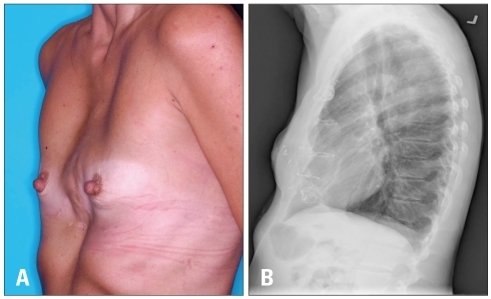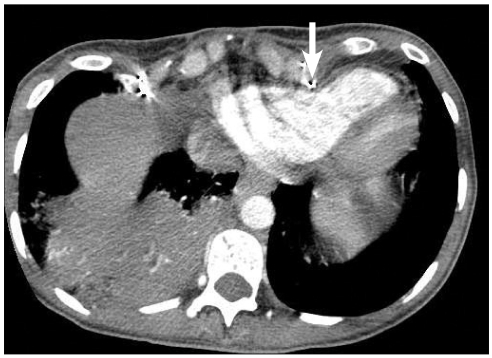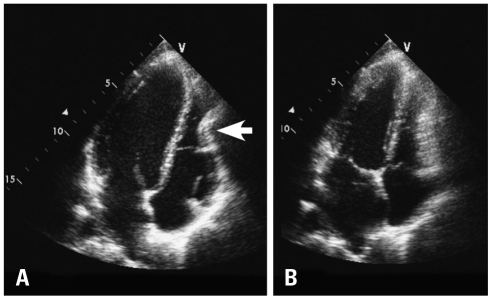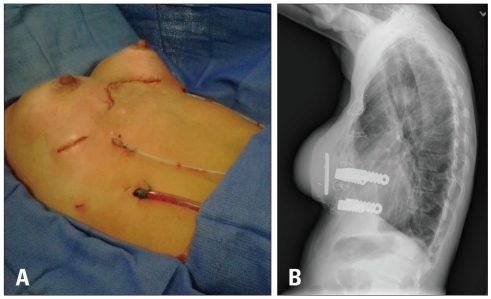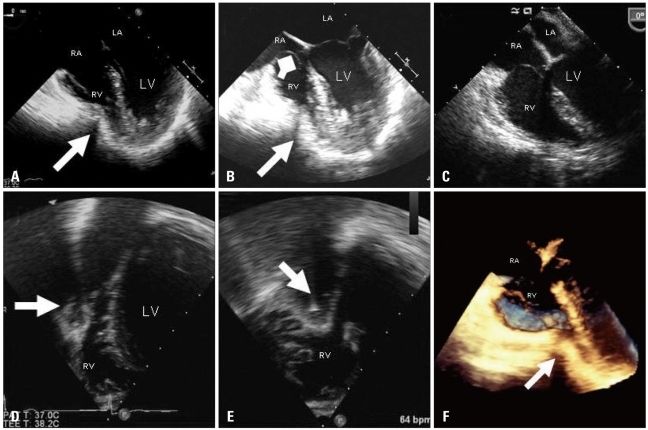J Cardiovasc Ultrasound.
2011 Dec;19(4):192-195. 10.4250/jcu.2011.19.4.192.
Right Ventricular Compression Observed in Echocardiography from Pectus Excavatum Deformity
- Affiliations
-
- 1Department of Surgery, Division Cardiothoracic Surgery, Mayo Clinic Arizona, Phoenix, AZ, USA. Jaroszewski.dawn@mayo.edu
- 2Department of Medicine, Division of Cardiovascular Diseases, Mayo Clinic Arizona, Phoenix, AZ, USA.
- KMID: 1980381
- DOI: http://doi.org/10.4250/jcu.2011.19.4.192
Abstract
- Pectus excavatum exists as varying anatomic deformities and compression of the right heart by the chest wall can lead to patient symptoms including dyspnea and chest pain with exertion. Echocardiography can be difficult but is critical to the evaluation and diagnosis of this patient population. Modifying standard views such as biplane transthoracic and 3-D transesophageal views may be necessary in some patients due to limitations from the abnormal anatomy of the deformed anterior chest wall. Apical four-chamber views when seen clearly can usually visualize any extrinsic compression to the right ventricle of the heart.
Keyword
MeSH Terms
Figure
Reference
-
1. Heinle J, Sabiston DC Jr. Sabiston DC, Lyerly HK, editors. Congenital deformities of the chest wall. Textbook of surgery: the biological basis of modern surgical practice. 1997. 15th ed. Philadelphia: WB Saunders Co;p. 1888–1896.2. Fokin AA, Steuerwald NM, Ahrens WA, Allen KE. Anatomical, histologic, and genetic characteristics of congenital chest wall deformities. Semin Thorac Cardiovasc Surg. 2009; 21:44–57. PMID: 19632563.3. Jaroszewski D, Notrica D, McMahon L, Steidley DE, Deschamps C. Current management of pectus excavatum: a review and update of therapy and treatment recommendations. J Am Board Fam Med. 2010; 23:230–239. PMID: 20207934.4. Jaroszewski DE, Fonkalsrud EW. Repair of pectus chest deformities in 320 adult patients: 21 year experience. Ann Thorac Surg. 2007; 84:429–433. PMID: 17643611.5. Jaroszewski D, Steidley E, Galindo A, Arabia F. Treating heart failure and dyspnea in a 78-year-old man with surgical correction of pectus excavatum. Ann Thorac Surg. 2009; 88:1008–1010. PMID: 19699946.6. Park SY, Park TH, Kim JH, Baek HK, Seo JM, Kim WJ, Nam YH, Cha KS, Kim MH, Kim YD. A case of right ventricular dysfunction caused by pectus excavatum. J Cardiovasc Ultrasound. 2010; 18:62–65. PMID: 20706572.7. Coln E, Carrasco J, Coln D. Demonstrating relief of cardiac compression with the Nuss minimally invasive repair for pectus excavatum. J Pediatr Surg. 2006; 41:683–686. discussion 683-6. PMID: 16567176.8. Krueger T, Chassot PG, Christodoulou M, Cheng C, Ris HB, Magnusson L. Cardiac function assessed by transesophageal echocardiography during pectus excavatum repair. Ann Thorac Surg. 2010; 89:240–243. PMID: 20103244.9. Mocchegiani R, Badano L, Lestuzzi C, Nicolosi GL, Zanuttini D. Relation of right ventricular morphology and function in pectus excavatum to the severity of the chest wall deformity. Am J Cardiol. 1995; 76:941–946. PMID: 7484836.10. Hawkins JA, Ehrenhaft JL, Doty DB. Repair of pectus excavatum by sternal eversion. Ann Thorac Surg. 1984; 38:368–373. PMID: 6486951.11. Raggi P, Callister TQ, Lippolis NJ, Russo DJ. Is mitral valve prolapse due to cardiac entrapment in the chest Cavity? A CT view. Chest. 2000; 117:636–642. PMID: 10712985.12. Fonkalsrud EW. Open repair of pectus excavatum with minimal cartilage resection. Ann Surg. 2004; 240:231–235. PMID: 15273545.
- Full Text Links
- Actions
-
Cited
- CITED
-
- Close
- Share
- Similar articles
-
- Cardiac Cachexia Caused by Right Ventricular Outflow Tract Obstruction in a Patient With Severe Pectus Excavatum
- A Case of Right Ventricular Dysfunction Caused by Pectus Excavatum
- Repair of Recurrent Pectus Excavatum with a Huge Chest Wall Defect in a Patient with a Previous Ravitch and Pectus Bar Repair: A Case Report
- Development of New Cardiac Deformity Indexes for Pectus Excavatum on Computed Tomography: Feasibility for Pre- and Post-Operative Evaluation
- Embarrassed Radiofrequency Catheter Ablation of Supraventricular Tachycardia in Pectus Excavatum

